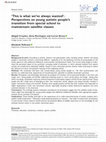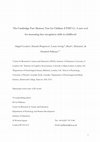Papers by abigail croydon
British journal of learning disabilities, May 10, 2024
Fagbokforlaget eBooks, Mar 24, 2022
Introduction to the study Theory of "practice architectures" Data collection and analysis Finding... more Introduction to the study Theory of "practice architectures" Data collection and analysis Findings and discussion Conclusion References

Autism & Developmental Language Impairments, 2019
Background & aims According to parents, teachers and policymakers alike, including autistic child... more Background & aims According to parents, teachers and policymakers alike, including autistic children and young people in mainstream schools is notoriously difficult – especially so for the significant minority of young people on the autism spectrum with additional intellectual, communication and behavioural needs. The current study sought to understand the perceived impact of one particular, emerging model of education, in which selected students from special schools are transferred to dedicated ‘satellite’ classes in local, mainstream partner schools, while continuing to receive the tailored curriculum and specialist teaching of the originating school. Methods We conducted interviews with London-based young autistic people ( n = 19), their parents/carers and teachers to understand their experiences of transitioning from specialist to satellite mainstream provision. Results Participants overwhelmingly welcomed the prospect of transition and its perceived benefits in the short and lo...

Journal of Experimental Child Psychology, 2017
Sensory information is inherently ambiguous. The brain disambiguates this information by anticipa... more Sensory information is inherently ambiguous. The brain disambiguates this information by anticipating or predicting the sensory environment based on prior knowledge. Pellicano and Burr (2012) proposed that this process may be atypical in autism and that internal assumptions, or ''priors," may be underweighted or less used than in typical individuals. A robust internal assumption used by adults is the ''light-from-above" prior, a bias to interpret ambiguous shading patterns as if formed by a light source located above (and slightly to the left) of the scene. We investigated whether autistic children (n = 18) use this prior to the same degree as typical children of similar age and intellectual ability (n = 18). Children were asked to judge the shape (concave or convex) of a shaded hexagon stimulus presented in 24 rotations. We estimated the relation between the proportion of convex judgments and stimulus orientation for each child and calculated the light source location most consistent with those judgments. Children behaved similarly to adults in this task, preferring to assume that the light source was from above left, when other interpretations were compatible with the shading evidence. Autistic and typical children used prior assumptions to the same extent to make sense of shading patterns. Future research should examine whether this prior is

Topics in Language Disorders, 2016
All children have the right to shape the decisions that influence their lives (United Nations Con... more All children have the right to shape the decisions that influence their lives (United Nations Convention on the Rights of the Child, 1989). Current policy frameworks in the United Kingdom (UK) emphasize the importance of involving young people with special educational needs (SEN) in the decisions that ultimately affect their education and wellbeing (e.g., UK Department of Education, 2014). For children to play a meaningful role in shaping these decisions, adults must be skilled at recognizing and discriminating communication bids by children. Facilitating children to contribute to decisions in this way can be accomplished by adults who recognize their communicative attempts and respond appropriately and consistently. The opportunity to contribute is crucial to the development of their autonomy (Nota, Ferrari, Soresi, & Wehmeyer, 2007). This can be a challenge for any child, but especially for children and young people with SEN, who often have speech, language, and social communication difficulties and who may not use traditional spoken means of expression (Cavet & Sloper, 2004). Despite school staff being legally mandated to facilitate all children, regardless of their abilities, to participate in everyday decisions, there is little research on the extent to which children's experiences and perspectives are elicited in schools and the methods for doing so. This is particularly true of those who have intellectual disability and are pre-verbal 1 or who have emerging language skills (determined by the use of signs, spoken words or symbols), with often-idiosyncratic ways of communicating, requiring a skilled adult communication partner for interpretation (Ware, 2004). In research settings, these children are often excluded by virtue of their limited communication and/or intellectual ability. One study, for example, reported the exclusion of 17 children who were pre-verbal, even though researchers had developed a range of creative 1 By 'pre-verbal', we mean a child or young person who can communicate intentionally (via verbal and nonverbal behaviors such as vocalizations, gestures or eye movements/gaze patterns), but does not yet use spoken words (or symbols) to communicate.

International Journal of Inclusive Education, 2018
Mapping inclusion of a child with autism in a mainstream kindergarten: How can we move towards mo... more Mapping inclusion of a child with autism in a mainstream kindergarten: How can we move towards more inclusive practices? This study identify and reflect on barriers to inclusion that children with autism can meet in kindergarten. We use a single case study with participant-and video observation to map inclusion for a single 5-year-old boy with autism, in a mainstream kindergarten in Norway. Analysis identified three modes of inclusion; distance-keeping, maintaining proximity and interacting. The mapping procedure demonstrated that barriers to inclusion continue to operate. The extent of the child's participation seemed to relate to what he was doing and who he was with; overall, limited social inclusion amongst peers being achieved. Results indicated that predictable frameworks and teacher support increased participation. We discuss how participation for children with autism can be promoted. Our study points toward the need to extend current adaptations and support to children with autism within the educational settings, to enable a more inclusive practice.
Fagbokforlaget eBooks, Mar 24, 2022
Introduction to the study Theory of "practice architectures" Data collection and analysis Finding... more Introduction to the study Theory of "practice architectures" Data collection and analysis Findings and discussion Conclusion References

Educational and Child Psychology
Aim:This study aimed to investigate the experiences of children and young people being educated i... more Aim:This study aimed to investigate the experiences of children and young people being educated in residential special schools, with a particular focus on how their rights and wellbeing were being promoted by their schools.Method:The study was conducted using participatory research principles and aimed to develop techniques and approaches that would support the inclusion of all children.Findings:The findings indicated that the techniques developed during this study helped to provide insight into the experiences of pupils with a wide range of special needs, and facilitated their voices. The piloting of a method that integrated ethnographic observation techniques with checklists adopted from the SCERTS framework (developed by Prizant and colleagues) provided important insights into the experiences and preferences of children with the greatest learning and communication needs, and is an approach worthy of further development.Limitations:The study was conducted over a very short time fr...
Using qualitative research to hear the voice of children and young people
Elsevier eBooks, 2023
Disabled people experience low employment rates, low pay and poor quality employment. Disadvantag... more Disabled people experience low employment rates, low pay and poor quality employment. Disadvantages persist through anti-discrimination and employment support measures. Improving social inclusion is an international goal for disabled people, and high value is placed on employment as the means to attain it. The example of people with intellectual and developmental disabilities in the UK is used in this chapter which draws on the Capability approach and feminist perspectives to argue for participation in ‘work’ – valued shared endeavours – rather than employment at any cost. Relational processes of sociocultural learning and mutual accommodation to extend capabilities and social inclusion are highlighted
Supplemental material, DLI886475 Supplemetal Material for 'This is what we've always want... more Supplemental material, DLI886475 Supplemetal Material for 'This is what we've always wanted': Perspectives on young autistic people's transition from special school to mainstream satellite classes by Abigail Croydon, Anna Remington, Lorcan Kenny and Elizabeth Pellicano in Autism & Developmental Language Impairments

Critical Social Policy, 2021
Social care provision across high-income countries has been transformed over the last ten years b... more Social care provision across high-income countries has been transformed over the last ten years by personalisation – a policy agenda to give people with eligible support needs more choice and control over their support. Yet the ideological underpinnings of this transformation remain highly mutable, particularly in the context of reduced welfare provision that has unfolded in many nations advancing personalisation. How the policy has manifested itself has led to an expectation for people to self-build a life as individual consumers within a care market. This article draws on a study exploring how people with learning disabilities in England and Scotland are responding to the everyday realities of personalisation as it is enacted where they live and show the relationality inherent in their practices. We propose that the personalisation agenda as it currently stands (as an individualising movement involving an increasing responsibilisation of individuals and their families) ignores the...
Yeoman for giving us the opportunity to work on such an important project with a group of young p... more Yeoman for giving us the opportunity to work on such an important project with a group of young people who are all too often excluded from social and leisure opportunities. We are also grateful to the professionals involved with Wac Arts who took the time to respond to our survey.

#SelfBuildingOurLives is a collaborative research project drawing upon the work of Andrew Power, ... more #SelfBuildingOurLives is a collaborative research project drawing upon the work of Andrew Power, Melanie Nind, Andy Coverdale, Hannah Macpherson and Abigail Croydon at University of Southampton, Ed Hall and Alex Kaley at University of Dundee, and a team of advisory group partners including people with learning disabilities and their respective organisations from across the UK. The The report draws on primary research we undertook in England and Scotland with people with learning disabilities, support organisations and commissioners. This was funded by the Economic and Social Research Council (ESRC): Reclaiming social care: Adults with learning disabilities seizing opportunities in the shift from day services to community lives (ES/P011764/1). The views expressed are those of the authors and not the ESRC. It also draws upon the feedback from participants at a national impact event held in London on 13 November 2019 and feedback received via social media (@SelfBuildLives).
Disability & Society, 2020

Neuropsychologia, 2014
Face recognition ability follows a lengthy developmental course, not reaching maturity until well... more Face recognition ability follows a lengthy developmental course, not reaching maturity until well into adulthood. Valid and reliable assessments of face recognition memory ability are necessary to examine patterns of ability and disability in face processing, yet there is a dearth of such assessments for children. We modified a well-known test of face memory in adults, the Cambridge Face Memory Test (Duchaine & Nakayama, 2006), to make it developmentally appropriate for children. To establish its utility, we administered either the upright or inverted versions of the computerised Cambridge Face Memory Test-Children (CFMT-C) to 401 children aged between 5 and 12 years. Our results show that the CFMT-C is sufficiently sensitive to demonstrate age-related gains in the recognition of unfamiliar upright and inverted faces, does not suffer from ceiling or floor effects, generates robust inversion effects, and is capable of detecting difficulties in face memory in children diagnosed with autism. Together, these findings indicate that the CFMT-C constitutes a new valid assessment tool for children's face recognition skills.











Uploads
Papers by abigail croydon